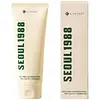What's inside
What's inside
 Key Ingredients
Key Ingredients

 Benefits
Benefits

 Concerns
Concerns

No concerns
 Ingredients Side-by-side
Ingredients Side-by-side

Water
Skin ConditioningMyristic Acid
CleansingGlycerin
HumectantPotassium Hydroxide
BufferingPalmitic Acid
EmollientStearic Acid
CleansingCoco-Betaine
CleansingLauric Acid
CleansingGlyceryl Stearate
EmollientSorbitan Olivate
EmulsifyingCaprylyl Glycol
Emollient1,2-Hexanediol
Skin ConditioningSodium Chloride
MaskingSalicylic Acid
MaskingButylene Glycol
HumectantHydroxypropyl Starch Phosphate
Ethylhexylglycerin
Skin ConditioningBifida Ferment Lysate
Skin ConditioningSynthetic Beeswax
Emulsion StabilisingDisodium EDTA
Pinus Densiflora Leaf Extract
AntimicrobialCentella Asiatica Extract
CleansingLactobacillus Ferment
Skin ConditioningAsiatic Acid
Skin ConditioningAsiaticoside
AntioxidantMadecassic Acid
Skin ConditioningMadecassoside
AntioxidantBambusa Vulgaris Extract
Skin ConditioningChamaecyparis Obtusa Leaf Extract
Skin ConditioningThuja Orientalis Extract
AntimicrobialWater, Myristic Acid, Glycerin, Potassium Hydroxide, Palmitic Acid, Stearic Acid, Coco-Betaine, Lauric Acid, Glyceryl Stearate, Sorbitan Olivate, Caprylyl Glycol, 1,2-Hexanediol, Sodium Chloride, Salicylic Acid, Butylene Glycol, Hydroxypropyl Starch Phosphate, Ethylhexylglycerin, Bifida Ferment Lysate, Synthetic Beeswax, Disodium EDTA, Pinus Densiflora Leaf Extract, Centella Asiatica Extract, Lactobacillus Ferment, Asiatic Acid, Asiaticoside, Madecassic Acid, Madecassoside, Bambusa Vulgaris Extract, Chamaecyparis Obtusa Leaf Extract, Thuja Orientalis Extract
Water
Skin ConditioningCoco-Betaine
CleansingSodium Cocoyl Alaninate
Potassium Cocoyl Glycinate
Acrylates Copolymer
Glycerin
Humectant1,2-Hexanediol
Skin ConditioningPropanediol
SolventPolyglyceryl-4 Caprate
EmulsifyingCaprylyl Glycol
EmollientHydroxyacetophenone
AntioxidantTromethamine
BufferingGlyceryl Glucoside
HumectantDisodium EDTA
Hydrolyzed Hyaluronic Acid
HumectantSqualane
EmollientEctoin
Skin ConditioningCitric Acid
BufferingHydrolyzed Vegetable Protein
Skin ConditioningMaltodextrin
AbsorbentHydrogenated Lecithin
EmulsifyingCeramide NP
Skin ConditioningButylene Glycol
HumectantHyaluronic Acid
HumectantHydrolyzed Sodium Hyaluronate
Skin ConditioningSodium Hyaluronate
HumectantPotassium Hyaluronate
Skin ConditioningHydroxypropyltrimonium Hyaluronate
Sodium Hyaluronate Crosspolymer
HumectantSodium Acetylated Hyaluronate
HumectantWater, Coco-Betaine, Sodium Cocoyl Alaninate, Potassium Cocoyl Glycinate, Acrylates Copolymer, Glycerin, 1,2-Hexanediol, Propanediol, Polyglyceryl-4 Caprate, Caprylyl Glycol, Hydroxyacetophenone, Tromethamine, Glyceryl Glucoside, Disodium EDTA, Hydrolyzed Hyaluronic Acid, Squalane, Ectoin, Citric Acid, Hydrolyzed Vegetable Protein, Maltodextrin, Hydrogenated Lecithin, Ceramide NP, Butylene Glycol, Hyaluronic Acid, Hydrolyzed Sodium Hyaluronate, Sodium Hyaluronate, Potassium Hyaluronate, Hydroxypropyltrimonium Hyaluronate, Sodium Hyaluronate Crosspolymer, Sodium Acetylated Hyaluronate
 Reviews
Reviews

Ingredients Explained
These ingredients are found in both products.
Ingredients higher up in an ingredient list are typically present in a larger amount.
1,2-Hexanediol is a synthetic liquid and another multi-functional powerhouse.
It is a:
- Humectant, drawing moisture into the skin
- Emollient, helping to soften skin
- Solvent, dispersing and stabilizing formulas
- Preservative booster, enhancing the antimicrobial activity of other preservatives
Butylene Glycol (or BG) is used within cosmetic products for a few different reasons:
Overall, Butylene Glycol is a safe and well-rounded ingredient that works well with other ingredients.
Though this ingredient works well with most skin types, some people with sensitive skin may experience a reaction such as allergic rashes, closed comedones, or itchiness.
Learn more about Butylene GlycolCaprylyl Glycol is a humectant and emollient, meaning it attracts and preserves moisture.
It is a common ingredient in many products, especially those designed to hydrate skin. The primary benefits are retaining moisture, skin softening, and promoting a healthy skin barrier.
Though Caprylyl Glycol is an alcohol derived from fatty acids, it is not the kind that can dry out skin.
This ingredient is also used as a preservative to extend the life of products. It has slight antimicrobial properties.
Learn more about Caprylyl GlycolCoco-Betaine is the natural version of Cocamidopropyl Betaine. It is often derived from coconuts.
Coco-Betaine is a surfactant, meaning it helps remove dirt and oil from the skin.
Disodium EDTA plays a role in making products more stable by aiding other preservatives.
It is a chelating agent, meaning it neutralizes metal ions that may be found in a product.
Disodium EDTA is a salt of edetic acid and is found to be safe in cosmetic ingredients.
Learn more about Disodium EDTAGlycerin is already naturally found in your skin. It helps moisturize and protect your skin.
A study from 2016 found glycerin to be more effective as a humectant than AHAs and hyaluronic acid.
As a humectant, it helps the skin stay hydrated by pulling moisture to your skin. The low molecular weight of glycerin allows it to pull moisture into the deeper layers of your skin.
Hydrated skin improves your skin barrier; Your skin barrier helps protect against irritants and bacteria.
Glycerin has also been found to have antimicrobial and antiviral properties. Due to these properties, glycerin is often used in wound and burn treatments.
In cosmetics, glycerin is usually derived from plants such as soybean or palm. However, it can also be sourced from animals, such as tallow or animal fat.
This ingredient is organic, colorless, odorless, and non-toxic.
Glycerin is the name for this ingredient in American English. British English uses Glycerol/Glycerine.
Learn more about GlycerinWater. It's the most common cosmetic ingredient of all. You'll usually see it at the top of ingredient lists, meaning that it makes up the largest part of the product.
So why is it so popular? Water most often acts as a solvent - this means that it helps dissolve other ingredients into the formulation.
You'll also recognize water as that liquid we all need to stay alive. If you see this, drink a glass of water. Stay hydrated!
Learn more about Water